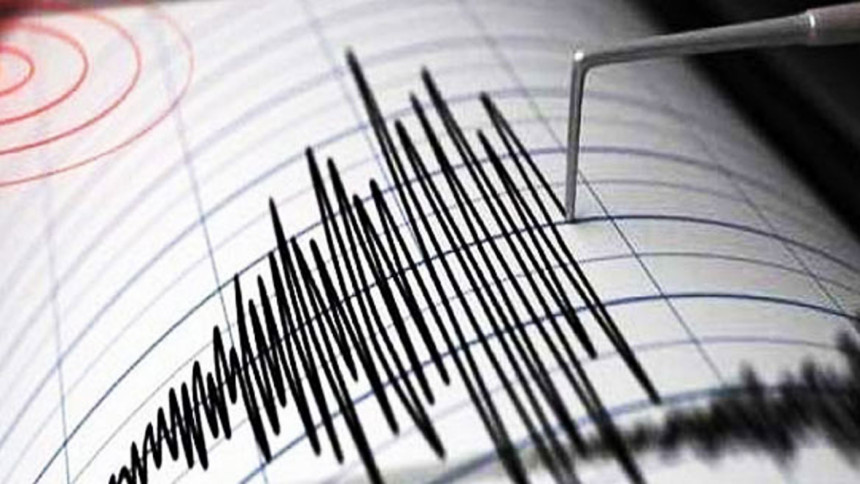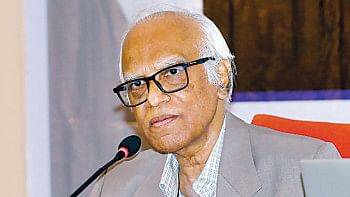What if a 7.9 Richter-scale earthquake hit Dhaka?

The runway of Dhaka's international airport was torn asunder along the axis. The damage forced all international flights—carrying emergency medical supplies, food, temporary shelters, and heavy-duty rescue machines—to divert to Chittagong and Sylhet. Large cargo helicopters like Chinook airlifted emergency aid to makeshift sites in and around Dhaka. Local and international aid workers laboured round the clock to bring help to as many Dhakaites as possible. But time was running out, as over 2 million people desperately waited for urgent medical care all across the city.
A temporary shelter was created along the entire length of Manik Mia Avenue, where nearly 400,000 people huddled under tarpaulin tents. Yards away from there, a forlorn government official at an emergency kiosk intently listened to a radio. A sombre voice on BBC spoke: "Two days ago the Bangladesh capital Dhaka and its surrounding areas were hit by a seismic Armageddon of magnitude 8.2 on the Madhupur fault. The devastation is incalculable."
CNN reporter Jordan Fitzgerald, along with his local journalist colleague, Raihan Adil, scoured the city by foot, bicycle, and motorbike for a glimpse into what was one of the most devastating earthquakes in modern times.
There were collapsed buildings everywhere, debris-strewn and split city arteries, and decomposing human bodies, making the city unnavigable. Shell-shocked homeless people squatted on the streets, wailing and crying out for help. The quiet of the city was occasionally perturbed by the shrill siren of ambulances and the thudding noise of drilling machines, trying to reach the dark womb of flattened buildings in search of survivors.
Raihan Adil and Jordan Fitzgerald furiously pedalled their bicycles on their way to old Dhaka, one of the gruesome epicentres of the wreckage. It has been reported that almost 80 percent of old Dhaka's buildings have been levelled. Worse still, the old city's narrow, crooked streets remained mostly inaccessible to any rescue efforts, and injured people perished without any medical help.
Still numb from the jolt 48 hours ago, Raihan dolefully asked his CNN colleague, "Jordan, do you have the latest number of people killed?"
"Well, I only have an unofficial CNN estimate. Approximately 570,000 people have been reported dead or missing so far. Do you know that this is more than the combined human casualty in the two deadliest modern-era earthquakes? The 7.5 quake near Beijing in 1976 killed 240,000. The one in Port-au-Prince, Haiti, in 2010, had a lower magnitude of 7.0, but it took the lives of about 316,000 people."
"You can never predict things accurately about earthquakes because they are Mother Nature's sheer eccentricities!"
Raihan agreed, "That's true. But I keep thinking about the 1897 Great Assam Earthquake, eight years before the Bengal Partition that put East Bengal and Assam together. That quake had a higher magnitude of 8.7, but it claimed only 1,626 lives."
"Well, you are talking about a region more than a century earlier. But it is a radically different scenario now. The population has increased manifold. Built-up areas spread like an octopus. The rapid urbanisation of mostly agrarian societies resulted in poorly planned cities, crammed with people and shoddy buildings."
"Yes, you are right. It is now a totally different urban geography. In 1900, Dhaka's population was only a little over 100,000. In 1961, it was around 500,000. Even when the country became independent, Dhaka was a city still with a rural flavour, marked by a sparse population. But within three decades or so the city became a megalopolis, competing with Tokyo, Mexico City, Mumbai, and Karachi! But look at it now. It is like a ghost city. It's worse than a nightmare…But, you know, I saw it all coming…"
Surprised, Jordan asked "How? What do you mean?"
"The city grew too fast too soon and, sadly, there has been very little planning for the seismic menace in Bangladesh. True, earthquakes are one of nature's compositional irrationalities, inexplicably embedded in the DNA of the planet. You can't prevent them, but you can surely prepare well to minimise their effects. There was very little effort to shore up critical facilities like hospitals, schools, and airports. There were no concerted national initiatives for the capacity building of earthquake professionals."
Jordan agreed and said, "Yes, you are totally right about pre-planning for earthquakes. Do you remember two recent quakes and their very different results? The most powerful magnitude ever recorded on Earth was 9.5 in the Great Chilean Earthquake in 1960, with its epicentre being 350 miles south of Santiago. Approximately 6,000 people were killed in that quake. But Chile learned a valuable lesson from the jolt. It developed appropriate seismic design codes for new buildings. These codes allowed buildings to endure strong vibrations later on."
As he pointed to collapsed buildings along Nazimuddin Road in old Dhaka, Raihan asked, "Then what happened?"
"Well, there was another strong 8.8 quake in Chile 50 years later, in February 2010. The death toll was only 550. But then compare this earthquake in Chile with a weaker one that devastated Haiti a month earlier, in January of 2010. The Haiti quake's magnitude was 7.0, but it reportedly killed 316,000 people. Why such a discrepancy? Of course, the difference is partly due to the differing distance between the epicentre of two earthquakes and human settlements. But the experts also think that Chile's planning and capacity building for seismic mitigation since 1960 made a huge difference."
"So, the Chileans were better prepared?"
"Yes, on many fronts. Think about this. A building stands up because it has a concrete cage of vertical columns and horizontal beams, all strengthened by steel reinforcements. When there is a strong geologic vibration, the structural members of the cage tend to buckle and collapse. To gird against this seismic threat, the Chileans systematically followed what is known as the 'strong columns weak beams' system."
"What is this system?"
"When an earthquake strikes, according to this system the concrete on the beams should break near the end, dissipating a lot of energy of the quake. But because there is steel reinforcement in the beams, they ultimately survive and columns remain standing up. There may be a bit of damage here and there in the structure, but the building would not collapse to the ground. As for Haiti, the country has a much poorer economy, and the buildings there are built with little regulation, let alone seismic considerations. The stark difference between the devastations of the Chilean and Haitian earthquake in 2010 offers an invaluable lesson."
Raihan nodded approvingly, "See, there have been frequent minor tremors in Bangladesh during the past 10 years. The government has been strengthening building codes based on a revised seismic map. Its disaster agency was even training nearly 75,000 volunteers in earthquake response. There were indeed some efforts."
As they turned a corner in Armanitola, Jordan asked impatiently, "So what happened? Why this massive destruction in Dhaka?"
"I suspect that seismic building codes remained mostly policies on paper. They were not widely adopted or implemented. The government agencies were very poorly equipped to monitor building constructions and assess post-occupancy building performance. Besides, the government had very little control over the private-sector building industry."
Jordan and Raihan reached Babu Bazar. They had to put on masks because the putrid air of ghostlike old Dhaka became unbearable. They now slowly approached Ahsan Manjil. A makeshift hospital has been set up in front of the partially damaged Nawab house. Two Red Cross helicopters just descended there and a foreign medical team hurriedly approached an emergency operation theatre under a large tent.
It was on the bank of River Buriganga that Dhaka began as a modest city centuries ago. Looking at the ruins Raihan wondered whether it would end here too. But he resolved not to give up on his beloved city. In case Dhaka survived this time around, the earthquake should be a solemn reminder for a fresh beginning.
Adnan Morshed is an architect, architectural historian, and urbanist. He teaches in Washington, DC, and serves as Executive Director of the Centre for Inclusive Architecture and Urbanism at BRAC University. His books include DAC/Dhaka in 25 Buildings (2017).
Email: morshed@cua.edu


 For all latest news, follow The Daily Star's Google News channel.
For all latest news, follow The Daily Star's Google News channel. 



Comments